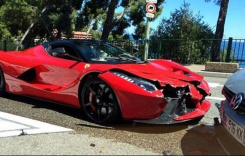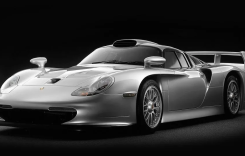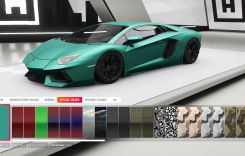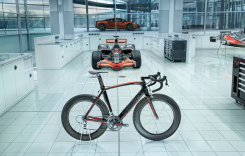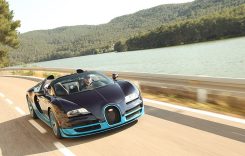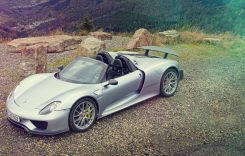The bloodline is there. The front fender sweeps forward like a cresting wave, its lines established long ago in classics like the 1948 Indian Chief. The chief’s head is there, perched in its place on top of the heavily valanced front fender, eyes pointed toward the road ahead. The twin cylinders sit cradled in a steel A-frame beneath a tapered tank, the Indian logo still scripted across the tank’s side. The leather seat is wide, comfy and inviting, ready for the long haul, but luckily it isn’t the sprung seat of old. Suspension duties have been graciously removed from the saddle and delegated to a single rear shock. After all, Indian Motorcycles set out to capture the iconic image in the new bikes, not the antiquated ride. The deep-skirted rear fender rolls behind like the next wave in a set, maintains the bikes smooth, flowing balance. Distressed brown leather saddlebags contribute to the bike’s vintage appeal. Yes indeed, the Indian Motorcycle’s bloodline is obvious.

I admire the classic styling of the 2010 Indian Chief Roadmaster while parked at the Crazy Horse Memorial in South Dakota. Taking photos is becoming a challenge. I’m parked at the bottom of a set of stairs that leads to the museum and almost everybody that passes by stops to admire the bike. Many ask me what year it is, and are surprised when they find out it’s a 2010 model. The fact that they can’t tell the difference between the newest rendition and the classics means that Indian Motorcycles’ styling department hit the nail on the head when designing the new bikes.
Taking photos in front of the Crazy Horse Memorial proved challenging because everybody who walked by wanted to talk about the eye-catching styling of the 2010 Indian Chief Roadmaster.
The group responsible for the latest resurrection of Indian Motorcycles is a private equity firm called Stellican Ltd. The company has been successful in reviving other iconic brands, like Chris-Craft boats, Riva yachts, and even the Italian soccer team, Vicenza. But bringing the motorcycle company back to the prestige it once enjoyed is an entirely different challenge. Indian started out with a bang over 108 years ago, but the success the original company enjoyed hasn’t manifested in its successors, and in 1977 the company declared bankruptcy. That dark episode of Indian Motorcycle’s history was followed up by the Gilroy years, another period of mismanagement and questionable production. But six years after the last Gilroy Indian was produced, the first new Indian Chiefs rolled off the Kings Mountain, NC, assembly line, breathing life again into the once proud marque. The question is, would the new Indians live up to standards set by company’s founders, George Hendee and Oscar Hedstrom? We took a ride on the 2010 Indian Chief Roadmaster during our recent trip to Sturgis in our quest to find the answers.
Sitting on the Roadmaster for the very first time, the bike feels tall with its 27.9-inch seat height. The handlebar height is up in comparison to its competitors, with a rider’s arms straight out just below shoulder height. Throw in a good stretch to the forward-mounted footboards and you’ve got ergos with a slightly-forward tilt in the upper back and a slight curve of the lower back that’s supported by the thickly padded leather seat. A fuel tank that’s relatively slim despite its 5.6-gallon size lets you snug up tight to the bike and take advantage of the wind-deflecting properties of the tall, quick-release windshield.
Providing the pulse to the new Indian Chiefs is a proprietary 45-degree air-cooled V-Twin with closed-loop fuel injection.
Both clutch and brake levers are four-way adjustable, so I click both in a single measurement for my grip size. The clutch lever pull is firm but not overly stiff. The convenience of a thumb-operated electric starter is not lost when firing up a big bike like this, and with a push of a button the electronically-fed cylinders spark to life reliably. Indian’s proprietary engine sits tall in the frame, big chrome-capped heads on a pushrod V-Twin. The room is needed for the tall heads and the 4.25-inch stroke of the pistons working within the 3.96-inch bore. A few twists of the throttle let’s you know that it is rigid-mounted to the frame by the vibrations in your knees.
My first ride started with twisting roads through the Black Hills along a back route to the Crazy Horse Memorial. Slick roads and fog aren’t ideal testing conditions, but the weather broke and I was finally able to open the Roadmaster up beyond second gear. Giving the throttle an aggressive twist, there is a noticeable rattle from the top bracket of the headlight housing when accelerating caused by the vibrations. The engine’s powerband overall is fairly broad, topping out in the 5200rpm range, but the engine could be tuned to give a little more grunt down low. The engine performs favorably in the top end, but lacks the surge down low of the Harley-Davidson TC 96 or Victory’s Freedom 106. At South Dakota’s 75-mph highway speeds in top gear, the rigid-mounted engine again gets a little vibey around the tank.
The 2010 Chief Roadmaster’s front end features a tear drop-shaped halogen headlamp and auxiliary lighting. The windscreen is detachable, and the stock mirrors deserve props for offering a great field of view.
Getting up to speed on Intersate 90 gives me a chance to run through the Roadmaster’s gears where I get a pleasant surprise. The transmission is impressively smooth. Each gear engages easily with a quick flick on the heel/toe shifter without the usual clunkiness of a V-Twin tranny. Neutral was easy to find on the constant mesh six-speed transmission, and power transfer to the belt-driven rear end was even. First gear will get you into the low 40s and 6th gear, with its 1:1 ratio, keeps rpm and vibrations low up until around 70 mph. The Indian’s six-speed transmission has no problems doling out the power of the 1720cc PowerPlus engine.
The South Dakota countryside rolls through green hills and craggy spires as the road winds through pine-laden countryside. The curves are mostly long and flowing, with the occasional tight 20-mph bend thrown in to keep you honest. The bike handles well for a motorcycle with a claimed weight of 747 lbs squeezed in between a long 68.4-inch wheelbase. The chassis is dialed in and feels planted at speed in turns and the floorboards are up high enough that I get a pretty generous lean angle before scraping. The 41mm front fork and 130mm-wide tire keep the front end firmly planted while a single-shock and swingarm on the back side team with a narrow 150mm rear tire to give the bike its friendly handling traits. The ’10 Chief Roadmaster is well-balanced and manageable at slow speeds as well.
The soft, distressed brown leather saddlebags and seat tie in to the vintage styling of the 2010 Indian Chief Roadmaster. The seat is as plush and comfy as it looks.
And while the bike gets better-than-average marks in the handling department, its braking arrangement was less than stellar – a surprise, considering the front features Brembo brakes with chromed dual calipers. The 11.5-inch dual floating rotors and 4-piston caliper arrangement lack initial bite. The single caliper floating rotor arrangement on the rear isn’t much better and locks up instead of keeping the pressure constant. Used in tandem, they get the job done, but independently they lack the power to bring the big bike to a stop fast. Whether Indian is pursuing ABS as an option is unknown, but bikes of this bulk can benefit from such a system.
Chugging down the scenic South Dakota highways, the front windscreen is tall enough that it’s out of my field-of-view. If you don’t like it, it pops off easily enough to give more of a cruiser look. Checking my speed is easy thanks to an analog speedo that sits high in the center of a tank-mounted console. Below the round dial of the speedo are a handful of digital display lights, like a neutral indicator and low fuel light. Instrumentation is fairly basic. The back of the headlight housing does have a cool 12 Volt plug-in on the rider’s right-hand side, and a switch for the auxiliary lights on the left, but the square housing is a little bulky from the
The die-cast console on the tank includes a speedo and multi-function displays like a low fuel light and neutral indicator.
rider’s viewpoint. The view from the front, on the other hand, is super clean, with a big chromed tear drop halogen headlamp in the middle flanked by two driving lamps. The chrome control housing and mirrors keep the bars tidy and the look sharp, and the mirrors provide an impressive field-of-view. The turn signals aren’t self-cancelling, and I left them on numerous times. Flashing fingers of passing riders were quick to bring it to my attention. It’s nothing that wouldn’t be remedied by habit.
The 2010 Indian Chief Roadmaster is a combination of classic lines and contemporary performance. Its studded seat with distressed brown leather and Roadmaster saddlebags give it an antiquated look. The bags are made of supple leather and are wide enough to stuff a leather jacket in. The deeply-valanced front fenders and spoked wheels are reminiscent of an era long past. But the big engine with EFI and shiny two-into-one stainless steel exhaust with a three-way catalytic converter are state-of-the-art. Old school meets new. An Indian for the 21st century.
The new owners of Indian Motorcycles have done a commendable job capturing the essence of the iconic American motorcycle brand. The 2010 Chief Roadmaster is visually striking. The fit and finish is high-quality, even down to the clean welds on the frame. Indian is going about things the right way by using a proprietary engine and keeping traditional styling cues. The bike handles and shifts well. The next step would be to quell the vibes of the engine a tad and to give it better stopping power. With a MSRP of $33,999, motorcyclists are going to expect
South Dakota’s Crazy Horse Memorial was a perfect backdrop for the impressive styling of the 2010 Indian Chief Roadmaster.
the bike to handle better than its less-expensive competitors. Harley-Davidson’s 2010 Softail Classic lists for $16,999, or $17,864 with custom color. Victory’s new hard-bagged cruiser, the 2010 Cross Country, is priced at $17,999. Exclusivity alone is a hard sell in tight times like these. And though the resurrection of Indian Motorcycles is headed in the right direction, a lower selling point has to be a topic of discussion in the Indian board room. Word is that the Scout is in the works, which traditionally is not only more sport-oriented, but lists cheaper as well. Expanding into more than one niche will only make the prospect of owning a high-end bike like the Roadmaster more attractive. The bloodline is there, and Indians will always hold a special place in American motorcycling lore. Judging by the new Indians, the company is seeking to have a place in the next chapters of motorcycle history as well.

